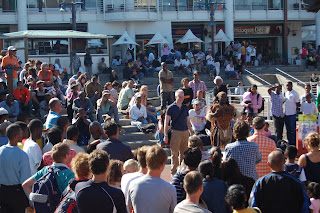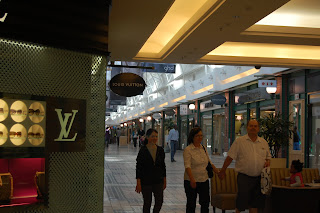Public spaces include all the spaces that people use on a daily basis. Public spaces have always been a great part of human life, sine time dated and played a fundamental role since the first time humans defined spaces such as public- and private spaces where they can serve as places where people can come together and exchange ideas to one another. Over the past years public spaces of cities have been places of diversity where people from all classes and different backgrounds could come together and be exposed to each other. In the 20th century there were rapid changes in public spaces disappearing to the growth of suburbs and new developments, and it moved people to more low-density neighbourhoods. And then the automobiles removed people from the public transportation, and gave them a more private and isolated space where they can move and go, as they want.
Pseudo-Public spaces can be defined nowadays as Malls, theme parks and sport stadiums. A pseudo-public space gives the idea of a space with its own diversity of people where they give the false impression that anyone can be a part of this space, while only certain people are welcome and invited into these spaces.
In normal public spaces it was never necessary to pay any fee to visit the particular place but nowadays we pay for parking when we use our own private transport when parking. But still Malls, theme parks and stadiums can be classified as more privatised and not so open to anyone than a normal park where you can walk your dog and still have the freedom to do “what ever you want”. And where as you can do what ever you want in normal public spaces these pseudo-public spaces, especially Malls, tend to control certain aspects like freedom of speech and disruptive actions by individuals, and security at the entrances of Malls will remove any one not suiting the status quo. These private spaces can control and “sanitize” the environment they move in and end any activities that can lead to chaos or the disruption to the consumer when spending money. Every thing has to be perfect in order to receive the best from the shopper and make them come back for more. A security guard stated in the article (Houssay-Holzschuch, Teppo, 2009,368 ) that street children and bergies are a nuisance and they disturb people, but if they do nothing to anyone then they are not allowed to do anything about them even if they struggle with them all the time.
Because going to the mall is a privilege to many of us today, the mall tries to create the most Utopia or hyperreality like environment for the shopper. This is aimed at the more upper-class sector of the community, like the white-middle class, tourists etc. People come to the mall to not only spend money on buying things but also on devoted social activities such as having drinks with friends and just hanging around. The mall can also function as a place where people can interact in a deeply divided society. The mall is also a more social than economic nature. Public spaces are still one of the few places where you can find a circulation of new and fresh ideas daily and it’s open to anyone. But why would people come to the waterfront? And who is it for? Firstly for the reason the place was built for, shopping. And secondly why people are supposed to come to the mall? It is stated in the article (Houssay-Holzschuch, Teppo, 2009,365) that all people can come; it is free to everyone and all types of people. And on the other hand it was pointed out that it’s not for people from Khayelitsha or people who can’t afford to spent money regardless of the heterogeneity of the crowd. The V&A waterfront are structured in such a way that it is very easy to spend money because it is such a commercial space and especially the layout of the mall. Referring to fig. 5. The second floor, in particular was more likely for the richer people and restricted access. As one can see the isle of the second floor is also not that busy or crowded by consumers.
There is fun and entertainment and games for everybody who can afford it. And then the outside of the mall is safer and in expensive and the space is more urban and free to all. All the activities of the mall is at the end generated towards the consumption of money.(Houssay-Holzschuch, Teppo, 2009,365). There are local as well as international shops and brands where you can basically find what ever you are looking for, making the environment more hassle free so the shopper finds it easier to spend more money and feel more relaxed while having entertainment as well as open spaces to move.
If one should look at the V&A waterfront you will find a big diversity of people of cultural differences, class ethnics and different backgrounds all exposed in one space, whether it is tourists, locals, elderly, and youngsters, male or female. The V&A waterfront is the most visited place in South Africa yearly by tourists. As this space is a pseudo-public space they unconsciously create an environment, in the mind of the consumer, of safety and luxury for the more privilege sector of the community, people can now find more security and experience a more enjoyable time when visiting this public space.
Unlike other malls, the V&A waterfront are mainly focused on tourists, where it is perfectly situated in the heart of Cape-Town. The V&A waterfront has become one of the most visited destinations in South Africa, where people can work, live, shop and play. The Waterfront offers impressive accommodation ranging from budget to more luxury and five-star, where the tenants are closer to the shops and entertainment. Making it easier for them to use the premises and spend more time, more money.
The V&A provides a range of eateries from fast food to fine dining in exclusive restaurants, a big variety to the diversity of people that visit the V&A. The V&A offers more than just shopping; there are activities like boat rides, seal-watching, helicopter tours and visiting the two oceans aquarium.
At the waterfront there is always surprised entertainment where you as viewer dos not have to spend a sent to watch, it’s out in the open air and attracts a lot of attention and eyes. Referring to fig. 3 & 4. And therefore the viewer will be captivated for a few more seconds or even hours and the stay will be longer as for normal malls, like the Adelphi mall that will be discussed later on. The mall can give a feeling of being in more magical world, like moving on a little island because the V&A is surrounded by water and there are a lot of boats everywhere and little markets along the road where the shopper move. It’s an ongoing cycle where the shopper can look around, buy something in the curio shop, move onto the boat trip and then head off to the restaurants and even catch a movie afterwards.
The V&A is so designed that escalators and stairs are positioned right next to each other to create more movement and a frequent flow and they made it possible for disabled people to access the mall as well. There are entrances on all the sides and thus it makes it easier to access the mall and move around. The main reason why people come to the V&A waterfront is to be part of the pleasure and the important activities despite all the shopping opportunities. “Every one is on display in this public urban space’s multiethnic show.” Is like a live stage and a social theatre, where people can watch and be watched. (Houssay-Holzschuch, Teppo, 2009,364)
As soon as surveillance cameras or even security guards comes in the picture of any so called public spaces it immediately turns into a pseudo public space where there is always a watch over individuals and the space become more impersonal and people get the feeling of being watched all the time. People are not that free and capable of doing what they want.
As Michel Foucault stated in his one article, “Diacritics”, is that the problem we might face one day is whether there will be enough space for mankind one day but also knowing what relations of propinquity, what type of storage, circulation, marking and classification of human elements should be adopted in a given situation in order to achieve a given end. The anxiety of our era is fundamentally with space, and no doubt that time also plays a role to make it possible for us to spread out in space. (Foucault, Miskowiec, 1986)
The Adelphi shopping center
The Adelphi shopping centre focuses mainly on daily need from a condensed choice of shops where you can quickly run in and run out to get what ever you need for the day. It is in contrast to the V&A waterfront where you can find the sensation of shopping and entertainment in one space.
The layout of the shopping centre is very simple and uncomplicated where you can find your way around easily. Its not that busy and expensive as the V&A waterfront because its not aimed at tourists and more focused on the local consumer for more everyday needs if you are in a hurry or on a budget. It’s basically you one stop easy access shop. There is not a lot of entrainment in the area because it’s on the main road with a lot of traffic. It is much more localised and aimed at the local people living in that area and around. This is a place where you can easily purchase and quickly departure to where ever. The atmosphere is much different than from the V&A waterfront where you get a kick out of going there, and move in a space of hyperreality, you don’t always know what you want when you go to the V&A and end up spending much more money on things like the movies, or other entertainment activities because you get captivated.
The atmosphere that Adelphi offers is a feeling of rush and discomfort because its not a pleasant place you will want to spend more time or move more slowly to take a look at things that interests you. The mall is not an interesting place or even entertaining at all. It’s not the ultimate destination to go and do your shopping but you will definitely find the basic of your needs. You won’t feel the need to dress up or do anything different to yourself because it’s not as exclusive as the V&A waterfront.
The lightning in the Adelphi shopping centre is very artificial where as in the V&A waterfront you get a lot of lighting from outside because of the many use glass panels and there is a constant sea breeze whether you move in the mall as physical building or outside on the waterfront by the sea an activities. The spacing in the mall is not very spacious like the big isle of the waterfront and basically you can walk in one way only. The tiles on the floor of the Adelphi shopping centre is also so laid out that it unconsciously lead people to walk in a specific direction.
Public spaces end exactly five meters from the entrance. The disappearing of more and more public spaces makes it harder for people to be individual and makes it harder for people to say what they want and think without being interrupted. People don’t mix and interact with different diversities of people and cultures anymore and thereby people loose creativeness and less exposure to new ideas. The welcoming and uses of perspectives are shut down when public spaces die out. Thus public spaces is so important to the society, but we still face some problems that also influences the usage of public spaces today like racism and discrimination it carried thru the years and left a mark on today’s life.
fig. 1
fig. 3
fig.4
fig. 5
Some example of public and pseudo-public spaces:
pseudo-public[image] retrieved April 11, 2010 from
twi-ny.com/twiny.07.15.09.html
light house [image] retrieved April 11, 2010 from
attractions.uptake.com/blog/lighthouse-cape-t...

public spaces, [image] retrieved April 11, 2010 from
flickr.com/photos/16555488@N00/3115838140

public spaces, [image] retrieved April 11, 2010 from
www.travelpod.com/.../1/1257130376/tpod.html

infecting the city, [image] retrieved April 11, 2010 from
theleoafricanus.com/tag/cape-town/page/2/
Bibliography
Battle to save the seafront 2008. Retrieved April 05, 2010 from
http://www.mg.co.za/article/2008-10-07-battle-to-save-the-seafront
Foucault, M, Miskowiec, J, 1989, Diacriticts, vol. 16, No. 1, (spring, 1986), Retrieved, April 09, 2010 from http://www.jstor.org/stable/464648
‘pseudo-public space’, Retrieved Apr il 06, 2010 from http://waua.wordpress.com/tag/pseudo-public-space/
Urban design. Retrieved April 07, 2010 from http://en.wikipedia.org/wiki/Urban_design









